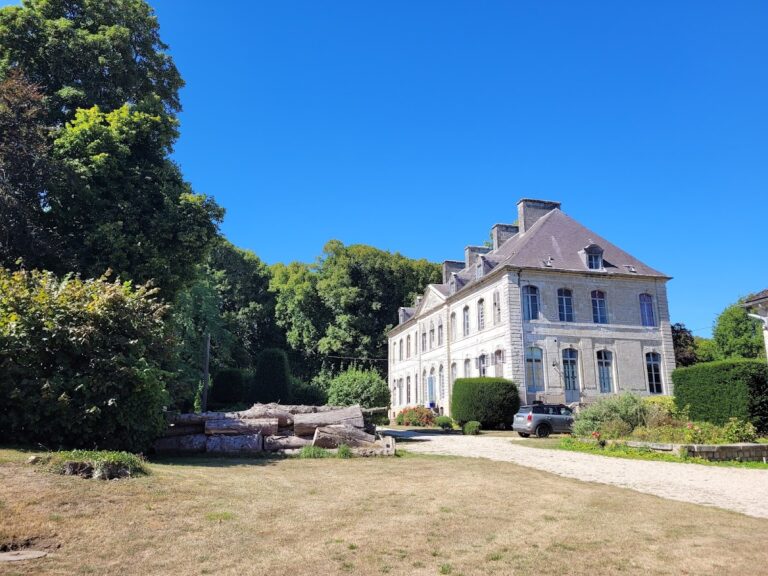Castle of Eaucourt-sur-Somme: A Medieval Fortress in France
Visitor Information
Google Rating: 4.1
Popularity: Low
Google Maps: View on Google Maps
Official Website: www.chateau-eaucourt.com
Country: France
Civilization: Unclassified
Remains: Military
History
The Castle of Eaucourt-sur-Somme stands in the commune of Eaucourt-sur-Somme, France, and was constructed by medieval European nobility during the 13th century. Its earliest recorded mention appears in a diocesan register from 1301, which refers to a chapel on the site dedicated to Saint Margaret. This chapel was established by Marguerite de Picquigny, the wife of Mathieu de Roye, indicating the castle’s connection to local aristocratic families and religious patronage during this period.
The castle’s origins likely tie to the strategic policies of King Philip Augustus, who reigned from 1165 to 1223 and commissioned new fortifications to secure lands recently brought under French control. It is probable that the lords of La Ferté initiated construction as part of this defensive expansion. The fortress first faced destruction in the mid-14th century, around 1358, when troops from the nearby town of Abbeville demolished it. This action aimed to prevent the castle’s occupation by English and Navarrese forces during the captivity of King John II. Despite this initial devastation, the castle was quickly rebuilt, underscoring its military importance.
In the early 15th century, during the turbulent decades of the Hundred Years’ War, the castle played a significant military role. Simon de Boulainvilliers served as captain in 1420, and the property was transferred to Jacques d’Harcourt, governor of Le Crotoy. Within a year, it fell to Anglo-Burgundian forces but was soon retaken by troops loyal to the Dauphin of France. Following its abandonment by these French forces, Philip the Good, Duke of Burgundy, ordered the castle to be burned in 1421. Jean d’Eaucourt then undertook its reconstruction in 1436 and resided there, marking a return to noble habitation.
The site experienced continued upheaval through the 15th and 16th centuries. In 1440, the castle was attacked and looted by Pierre Renaud de Vignolles, who captured the lord of Eaucourt and demanded ransom. Ownership passed through various noble hands, including marriages and inheritances: Isabelle d’Eaucourt’s marriage to Louis d’Humières in 1499, the lordship under Françoise de Soyécourt in 1575, and later stewardship by Dame de Belleforière-Soyécourt around 1700, followed by Joachim-Charles de Seiglière de Belleforière in the 18th century.
The late 16th century brought fresh conflict amid the French Wars of Religion. In 1589, the Catholic League supporters in Abbeville seized the castle from forces loyal to Henry IV, a period during which the castle was eventually dismantled. The last recorded occupant was François Vaillant, a knight who lived there from 1777 to 1779, after which the castle ceased to function as a residence or military post.
Remains
The Castle of Eaucourt-sur-Somme is enclosed within a roughly rectangular defensive wall measuring about 40 by 50 meters. This enclosure, or enceinte, was originally surrounded by protective ditches and reached heights of six to seven meters. The stone walls offered substantial security and enclosed the castle’s internal spaces, framing the fortified compound of this medieval stronghold.
The main entrance, situated on the northwest side, included a fortified gatehouse known as a châtelet. This structure functioned both as an entry point and a refuge, serving as a small keep (donjon) within the castle defenses. It was topped with machicolations—stone openings that allowed defenders to drop objects on attackers below—and flanked on the front by two round towers guarding the drawbridge. Behind the entrance, on the right rear side, stood a smaller watchtower featuring a spiral staircase, highlighting the layered defensive design.
Today, the entrance retains a restored lowered archway with visible grooves where the folding plank of the drawbridge once rested. Vertical slots used to operate the drawbridge’s lifting arms are also present. Inside the gate, a square vestibule called the “guard room” features a vaulted ceiling supported by ribbed cross vaults. Four secondary pointed arches buttress the vault, exemplifying the Gothic architectural style prevalent during the castle’s height.
At the rear of the fortified entrance, a doorway with a semicircular arch led toward the Baye river. Above this portal, a decorative panel displayed a hammered coat of arms flanked by a wild man and a triton—mythical figures often symbolizing strength and guardianship. This emblem bore the motto “Sans Ayde,” referencing a form of tax exemption granted to the castle’s inhabitants.
Most of the remaining defensive walls lie at ground level, with some wall fragments still standing at the castle’s rear. According to a detailed 1860 account by historian R. Belleval, the donjon was originally a separate square tower crowned by crenellations, or battlements, and surrounded by three round towers with pointed roofs and machicolations similar to those found at the nearby Château de Rambures. In 1795, this main tower remained largely intact and habitable. The roofs and towers preserved their structure, though some tiles were missing, revealing a complex wooden framework beneath.
The castle’s main courtyard was enclosed by walls in various states of ruin; portions still displayed battlements, with at least one prism-shaped turret capped with its original roof standing at a corner. Flat terracotta tiles formed the roofing material throughout the castle, a detail confirmed by archaeological evidence, while no slate roofing was recorded.
Recent archaeological surveys in 2015 uncovered foundational remains of a polygonal tower and the lordly residence situated opposite the entrance châtelet, further expanding knowledge of the castle’s layout and residential spaces. These discoveries reinforce the understanding of the castle as a carefully arranged fortification blending military and domestic functions across its medieval occupation.










